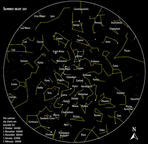
One of the joys of Kruger is to be able to study the night sky without the interference of city lights.
It is a humbling experience to consider one's insignificance in the face of the enormity of the universe. Our sun is part of the Milky Way galaxy, a small part of the ever-expanding universe, The Milky Way is a loose celestial spiral galaxy consisting of an estimated 100 000 million stars.Scientists estimate that it would take 100 000 years to travel at the speed of light from one end of our galaxy to the other - if one can indeed talk about the "end" of galaxies. Our sun - which is an estimated 32 000 light years from the galactic centre of the Milky Way, rotates once around our galaxy every 225 million years.Lonely Hunter of the Night Sky

There is an old San hunting legend concerning the stars. There was a proud hunter (Aldebaran) who had seven sisters (the Pleiades). Aldebaran was a confident hunter who only needed one arrow to shoot his target. One day his hungry wives implored him to go out hunting and not to return empty-handed. Aldebaran came accross three zebra (Orion's belt), and shot at them.
However, his hunting skill let him down and he missed all three animals. What was worse was that he could not retrieve his single arrow as it had landed near a huge lion (Betelgeuse) that had been stalking the zebra. So to this day Aldebaran has remained out in the cold night sky, too afraid to return home without food and too afraid to try and retrieve his arrow from the feet of the lion.

